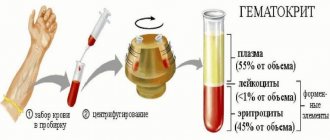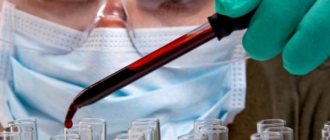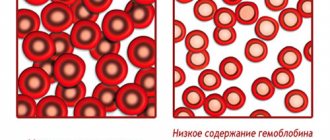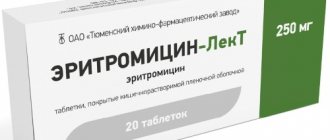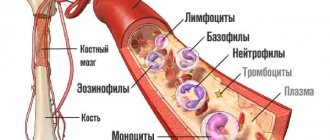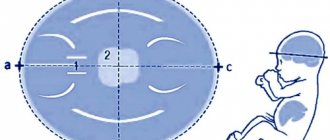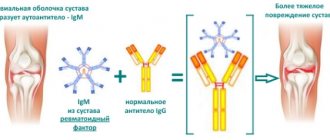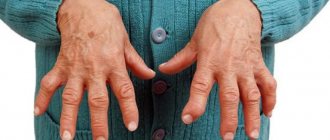What is the atherogenic coefficient
The atherogenic index is a characteristic of the ratio between “bad” and “good” cholesterol, or rather lipoproteins - compounds that ensure the delivery of cholesterol to the tissues of organs and systems. Unlike total cholesterol, the index provides more information about fat metabolism.
This is explained by the fact that cholesterol (a natural fatty alcohol) in the body is presented in the composition of 2 types of compounds:
- High density lipoproteins (HDL). They are easily soluble, do not tend to precipitate and provoke the growth of atherosclerotic plaques (they are not atherogenic). Moreover, “good” lipoproteins protect blood vessels from atherosclerotic changes by carrying cholesterol through the bloodstream. This is how fats get to the tissues that need them.
- Low density lipoproteins (LDL) and very low density lipoproteins (VLDL). These substances are poorly soluble, capable of precipitating in the form of crystalline cholesterol and forming atherosclerotic deposits on the vascular walls. In other words, LDL and VLDL have the property of atherogenicity. In general, atherogenic disorder is accompanied by three processes:
- increased total cholesterol;
- growth of “bad” lipoprotein compounds (LDL and VLDL);
- reduction of “good” cholesterol (HDL).
The atherogenicity index is an assessment of all 3 processes, expressed in one number.
The coefficient makes it possible to immediately answer the following questions:
- is there a tendency to atherosclerotic processes;
- how quickly the identified atherosclerosis progresses;
- whether dietary or lifestyle changes are required;
- Is there a need to prescribe drugs to lower cholesterol?
It should be noted that although an increase in cholesterol in the blood is considered the main condition for the development of atherosclerosis, the disease can also be diagnosed in people with a normal value against the background of:
- obesity;
- bad habits;
- metabolic disorders;
- high pressure.
What to do with reduced atherogenicity?
First you need to find out whether the result is correct. In other words, in the last days before the test, were there any factors in the patient’s life that could reduce the atherogenicity coefficient. If there are none, then the result can be interpreted as correct.
Eating foods with sufficient fat content
The most common problem is eating low-calorie foods with a critically low fat content. Numerous mono-diets, which today you can read and prescribe for yourself on the Internet, can be harmful even to a healthy person, not to mention patients with diseases. It is urgent to visit a nutrition specialist so that he can develop an individual schedule and diet, describe the types of foods and their quantities. In this case, the decision to consume everything in any quantities immediately after such a “starvation” diet is incorrect. This is fraught with a sharp increase in the level of sugar, low-density lipoproteins and other blood components.
As for athletes and their reduced atherogenicity coefficient, everything should be decided only by a sports doctor. Even the slightest deviation from the training schedule can cause failure in the near future, but it is precisely for the sake of victory that a person in this profession tries. Perhaps you should think about your diet and, if possible, add some foods with lipoproteins. By the way, the quality of lipids, namely their density, does not play the first role in the case of athletes, because most of the fats will be converted into energy. However, it has been noted that products with “good” lipoproteins do not cause a feeling of heaviness, which also gives them an advantage over products with animal fats.
Should you be a vegetarian?
Finally, a separate conversation should be had with vegetarians. As a rule, these people refuse animal fats, however, they also consume a very moderate amount of vegetable oils. If the work activity of such people is intense and intense, it does not matter whether it is physical or mental, then with a high degree of expectation we can say that the atherogenicity coefficient will be reduced. If a vegetarian’s diet is too meager, then his body will be in a state of exhaustion, and the reduced atherogenic index once again proves this. In this case, you should immediately think about your diet, namely, how to diversify it with foods containing fats, and here, too, the help of a specialist will not be superfluous.
How to calculate the atherogenic index
Formally, to calculate the atherogenic coefficient, you need to know only two values - total cholesterol and “good” cholesterol (HDL). However, since the test is prescribed to people who already have symptoms or suspected diseases, blood biochemistry or lipid profile (a highly specialized test to assess fat metabolism) includes an assessment of the concentration of:
- total cholesterol (Tot) – the sum of high, low and very low density lipoproteins;
- high density lipoproteins (HLLP);
- low and very low density lipoproteins (Klnp and Klonp);
- triglycerides (TG) - compounds found in the blood as part of Klonp.
The atherogenic index shows the ratio of bad and good cholesterol
To calculate the coefficient (depending on the laboratory and indications), the following ratios are used:
- Ka (atherogenic coefficient) = (Ktot – Klvp)/Klvp. Using this formula, the calculation can be made knowing only 2 parameters;
- Ka = (Klnp+Klonp)/Klvp. This formula is more visual; it shows that the atherogenic index is the ratio of “bad” cholesterol to “good”;
- Ka = (Klnp+TG/2)/Klvp. This calculation is similar to the previous one, but involves the determination of very low density lipoproteins through triglycerides.
The role of cholesterol
Cholesterol is a fat-containing alcohol that is produced by the body’s own cells - up to 80.0% (50.0% of this indicator is synthesized by liver cells) and 20.0% enters the body with food of animal origin.
Lipid metabolism is responsible for the balance of cholesterol in the body.
The role of cholesterol molecules in the body is very large:
- Cholesterol is found in every cell membrane and gives them elasticity and strength;
- Cholesterol molecules are responsible for the permeability of cell membranes and protect them from the influence of the external environment, increasing immunity to cells and the body;
- Participates in the production of steroid hormones by the adrenal glands;
- Cholesterol promotes the production of vitamin D by liver cells;
- High-density cholesterol molecules ensure normal bile production;
- Cholesterol binds neurons in the brain and spinal cord;
- Cholesterol molecules protect nerve fibers by coating them.
Low-density lipoproteins (LDL) are molecules that are building blocks of cell membranes. Without molecules of low-density lipoproteins, the vital activity of cells in the human body is impossible.
Low molecular weight (liquid) LDL cholesterol is used in the digestive organs to produce bile acids, and also activates the functioning of the immune system and all brain cells.
Liquid cholesterol takes part in balancing nerve endings.
Liquid cholesterol takes part in balancing nerve endings. It also leads to the restoration of the nervous system during and after overexertion and stress.
All the positive qualities of cholesterol are noted only if low molecular weight lipoproteins do not exceed the norm in the blood.
Then liquid cholesterol is not bad. If its concentration in the blood plasma increases, then low molecular density lipoproteins can harm the bloodstream system, as well as the entire body.
An excess amount of cholesterol in the blood contributes to the formation of cholesterol plaques, which, when growing, lead to the development of systemic atherosclerosis and pathologies of the heart organ.
Cardiac pathologies often result in myocardial infarction, as well as numerous pathologies of the vascular system, leading to cerebral stroke.
Excess cholesterol molecules begin to settle on the inner lining of the arteries, which leads to blockage of the arterial lumen, and can also lead to rupture of the lining and hemorrhage into the affected organ.
High molecular density lipoprotein (HDL) is the good, solid cholesterol that is quite useful in the body.
Its increased content in the blood indicates that the risks of developing pathologies of the vascular system and cardiac organ are minimal and the main lumens are cleared of excess cholesterol molecules.
A little about cholesterol
Norms for men and women
The atherogenic index is an indicator whose normal values depend on gender and age.
The standards are presented in the table:
| Age, years | Norma Ka (men) | Norma Ka (women) |
| 20–30 | less than 2.5 | less than 2.2 |
| 30–39 | 2,1–4,9 | 1,9–4,4 |
| 40–60 (in the absence of coronary heart disease) | 3,0–3,5 | less than 3.2 |
| 40–60 (in the presence of coronary heart disease) | 3,5–4,0 | 3,5–4,0 |
Values exceeding 3.2, but not reaching 4, can be called borderline. This calculation result suggests that atherosclerotic changes can occur soon, provoking thrombosis and ischemic disorders (therefore, during ischemia, such values are considered acceptable).
How to reduce (KA) to normal?
As a rule, a decrease in the coefficient (index) of atherogenicity has no clinical significance. However, its elevated values clearly indicate the predominance of conditionally “bad” cholesterol in the blood. Thus, the most important points to normalize lipid levels are the following steps.
- Courageous decision: QUIT SMOKING! (Usually, after consultation with a psychologist. Because the “root” of any addiction, including nicotine, is in the human soul. According to experts in this field of science, the main “mental” problem of most smokers is the “feeling of loneliness”).
- Dramatic changes in diet: starting with a complete rejection of trans fats (more detailed information about what you can and cannot eat for “cholesterol problems” is indicated in the TABLE
). - FOLLOWING A DIET by including in your diet foods that LOWER “BAD” cholesterol and INCREASE “GOOD” cholesterol ! You may have to significantly expand your horizons and hone completely new culinary skills. But in no case will you regret it!!!
- Serious changes in lifestyle (following medical recommendations / adding to your schedule: morning physical exercises, walking in the fresh air, classes in sports clubs, outdoor activities, etc.).
- And finally, treatment with special (CHOLESTEROL / LOWERING) medications (according to the recommendations of the treating specialist). But this is only a last resort!
Also read on our website: HOW TO EFFECTIVELY REDUCE CHOLESTEROL WITHOUT DRUGS
Reasons for increasing the atherogenic coefficient
An increase in the atherogenicity index to 4 or more (with rapidly progressing atherosclerosis, the index often increases several times) indicates that cholesterol is deposited and accumulates inside the vascular lines.
The reason for the process is a large confluence of lipoproteins that do not wash cholesterol out of the vessels, but leave it there.
Despite the fact that only 20–30% of cholesterol enters the body with food (the main amount is synthesized by the liver, kidneys, adrenal glands, and intestines), nutrition should be mentioned among the factors that increase the atherogenicity coefficient.
Among the negative features of the diet it should be noted:
- binge eating;
- abundant consumption of trans fats and “fast” carbohydrates (flour and confectionery products, fast food, chips, popcorn);
- lack of diet:
- fiber;
- polyunsaturated fatty acids (omega-3-6-9);
- vitamins (E and group B);
- trace elements and minerals (calcium, magnesium, iodine).
- insufficient intake of lipotropic substances into the body that help normalize lipid metabolism and protect the liver from fatty damage. The deficiency of lipotropics can be compensated by adding to the menu:
- beef;
- chicken eggs;
- lean fish and cottage cheese;
- soy flour.
The following diseases and lifestyle features contribute to an increase in the concentration of low molecular weight lipoproteins:
- heredity. The likelihood of developing atherosclerosis is higher in individuals whose blood relatives have heart and vascular disease in combination with high cholesterol. This phenomenon is called “familial dyslipoproteinemia”;
- continuous psycho-emotional stress and regular stress;
- excess weight or inadequate calorie intake (overeating);
- smoking. The substances contained in cigarette smoke not only contribute to intoxication of the body, but also cause vasospasm;
- low level of physical activity;
- disruption of the outflow of bile in liver diseases (60% of all cholesterol is produced in this organ) - this phenomenon can be triggered by abuse of alcohol or medications, or liver poisoning due to viral infections (cytomegalovirus, herpes, chlamydia). Viral diseases, in addition, can cause negative changes in the structure of the walls of blood vessels;
- endocrine disruption - high cholesterol and atherosclerosis often accompany diabetes. Also, disorders of fat metabolism are provoked by increased function of the adrenal cortex and a lack of production of hormones by the thyroid or gonads;
- hypertension - constant high blood pressure negatively affects vascular tone and can provoke significant atherosclerosis even with a slight increase in the atherogenic coefficient.
Atherosclerotic changes (and therefore high Ka) are more often diagnosed in men - this is due to lifestyle characteristics (alcohol abuse, smoking) and hormonal levels. Women are at risk after the age of 50 – during menopause, when the production of female hormones that protect blood vessels decreases.
The main danger of atherosclerosis is that cholesterol deposits in the vessels impair blood circulation in vital organs, causing myocardial infarction (an acute disturbance of the blood supply to the heart muscle) or stroke (an acute disturbance of the blood circulation of the brain).
In addition, cholesterol deposits can lead to the following dangerous conditions:
- atherosclerosis of the aorta;
- vascular aneurysms;
- atherosclerotic narrowing of the abdominal aorta;
- impaired blood supply to the kidneys, up to organ infarction;
- severe form of high blood pressure accompanied by renal failure;
- ischemic attacks - conditions similar to a stroke, but lasting no more than a day;
- damage to the blood vessels of the extremities.
A disruption of the blood supply to the brain, even if it does not provoke acute conditions, can lead to:
- deterioration of thinking and attention;
- decreased performance;
- fainting states;
- dementia.
Moreover, even minor atherosclerotic changes in the vessels affect the blood supply to any organ, worsening its functioning.
Deviations from the norm: causes, consequences and what to do
When calculating the atherogenicity coefficient, deviations can directly vary either upward or downward.
When the atherogenic index does not exceed normal values or its level is below normal, the likelihood of cardiovascular pathology tends to zero.
When the level of atherogenic number exceeds 4, the likelihood of ischemic changes in vital organs and thrombosis increases significantly. An atherogenic index of more than 5 indicates the presence of atherosclerotic changes in the vascular bed.
If an increase in the atherogenic coefficient is detected during the examination, measures should be taken immediately. An antiatherogenic diet plays a primary role in normalizing the indicator. The patient's diet is enriched with products that have an antiatherogenic effect. Many patients are concerned about the question of why diet . Normalization of nutrition allows you to reduce the atherogenicity coefficient by 10-20%, without resorting to the use of medications.
High index
Today, most adults over 50 years of age have an increased atherogenicity coefficient. The increase number varies from 5 and above. This is caused by disruptions in fat metabolism in the body. The main reasons that contribute to the increase in the coefficient are identified.
- Poor nutrition. Although most cholesterol is of endogenous origin (produced by the body), quite large amounts can come from foods containing a high concentration of animal fats. Fatty meats, hard cheeses, baked goods, sausages, margarine, butter, and fatty cottage cheese contain a lot of cholesterol. The method of preparing dishes is of great importance. So, when frying, it is necessary to add a large amount of fat, which significantly increases the cholesterol content in the output.
- Diabetes mellitus with overweight or obesity . These two diseases are closely interrelated, since their pathogenetic aspect is a violation of lipid-carbohydrate metabolism. In this group of people, the atherogenicity index is most often increased to high values.
- Addictions . Excessive drinking and smoking increases the atherogenicity coefficient and has a detrimental effect on the condition of blood vessels, causing heart disease and the risk of ischemic damage to vital organs.
- Diseases of the liver and thyroid gland . Pathological changes in the functioning of these organs adversely affect the state of fat metabolism. The balance between harmful and beneficial fractions of cholesterol is disturbed, which is reflected in an increase in the atherogenic coefficient.
- Physical inactivity . Many modern people lack physical activity. This is often due to a sedentary lifestyle and lack of personal time.
If the indicator increases, it is necessary to take measures aimed at reducing the atherogenic index.
If a doctor talks about the need for these measures, patients wonder what this means. The first thing you should do is review your diet, eliminating foods that are sources of cholesterol. It is necessary to eat food that has anti-atherogenic properties and is rich in fiber (fresh vegetables, fruits, leafy greens, fatty fish, cereals).
If you have bad habits (smoking, alcohol), you must give them up immediately. If just one remains, all efforts made will not be crowned with success.
It is also worth increasing your physical activity and ensuring that you get enough healthy sleep. It has been proven that with a lack of night sleep, metabolic processes slow down, which becomes the cause of various diseases. If there are concomitant pathologies (diabetes mellitus, liver pathologies, obesity), they should definitely be treated. Without this, it is problematic to reduce the atherogenicity coefficient.
With persistently high values of the atherogenicity number, it is justified to take drugs that reduce the level of “bad” lipids in the blood, preventing them from settling on the walls of the arteries. Modern cardiologists prefer to treat such patients with statins and fibrates . The selection of the drug, as well as the treatment regimen, depends on the individual clinical case.
One of the reasons for the excess of the normal number of atherogenicity in females during the reproductive phase is the use of contraceptives that affect hormonal levels. If a high coefficient is detected, you should contact a gynecologist-endocrinologist in order to correct the treatment regimen or replace the drug. After the onset of menopause, an increase in the index is quite normal.
Low index
A low atherogenicity coefficient does not occur as often as an increased one. Such people should not panic, because this means that atherosclerosis does not threaten them. The atherogenic index is less than normal values for a number of reasons:
- treatment of mycoses with antimycotic drugs or overdose of lipid-lowering drugs;
- irrational diet with a low content of nutritional components;
- professional sports, when the body experiences tremendous physical activity.
A decrease in the atherogenicity coefficient is observed in representatives of the fairer sex taking estrogen-containing drugs. When they are cancelled, the indicator returns to normal values.
A low atherogenic index does not need correction. On the contrary, this state of affairs indicates normal functioning of the vascular bed.
Reduction methods
The atherogenic index is an indicator of fat metabolism in the body, the balance between the production/intake of “bad” and “good” lipoproteins from food. Changing this ratio is a rather lengthy process that involves a set of measures, including:
- making lifestyle changes. Among the general recommendations here will be: giving up smoking and excessive alcohol consumption, normalizing work and rest schedules, reducing the stress load on the body;
- ensuring the required level of physical activity. In the absence of illnesses, you can train 4 times a week for 30–40 minutes - aerobic exercise, running, and various types of training that improve blood circulation and heart function are appropriate. If there are chronic disorders, the doctor may recommend gentle exercise. Even regular walking, cycling, or swimming can bring tangible benefits;
- elimination of a disease that provokes lipid metabolism disorders - this applies to diseases of the liver and endocrine system. Without first eliminating such disorders, adjusting the atherogenicity index is meaningless.
Nutrition for high cholesterol plays a special role. Not only the composition of the diet is important, but also the basic principles, including:
- Understanding the difference between healthy (fish oil, vegetable oil) and unhealthy (lard, fatty meats and fish, whole dairy products, fast food) fats.
- Eating food that has been steamed, boiled, stewed, or baked. Fried foods should be avoided.
- Maintaining a drinking regime - at least 2 liters of clean drinking water per day, supplementing this volume with green tea, juices and compotes.
- Small meals – 5–6 times a day, without overeating or “hungry” intervals.
Prohibited and recommended products are presented in the table:
| type of product | Allowed | Forbidden |
| Fatty dishes | Olive, sunflower, linseed oil - no more than 2 tbsp. l. in a day | Palm and coconut oil, lard, margarine |
| Meat dishes |
|
|
| Seafood | Boiled or steamed fish - no more than 2-3 times a week | Fried fish and canned fish |
| Broths | Broths with lean meat or vegetables | "Heavy" meat broths |
| Eggs and dairy products | egg white; skimmed milk; cottage cheese; yoghurts and low-fat cheeses. |
|
| Porridge and flour |
| Butter pastries |
| Vegetables and fruits | Any fruits and vegetables, fresh or frozen, dried fruits and legumes | Fruits in sugar or syrup, chips, fried potatoes |
| Dessert |
|
|
| Beverages |
|
|
| Sauces |
| Various sauces, especially mayonnaise. |
Medicines are prescribed if the increase in the atherogenic index is significant, or if the previously listed measures to change lifestyle and nutrition are ineffective (within 6 months).
In addition, taking medications is mandatory if you have:
- coronary heart disease;
- myocardial infarction or stroke;
- obesity;
- diabetes mellitus;
- confirmed heredity – cases of death due to cardiovascular diseases under 50 years of age in close relatives.
Among the types of medications used:
- Statins are drugs that inhibit enzymes involved in the production of cholesterol in the body. Statins improve the quality of vascular walls damaged by small deposits and normalize blood viscosity. The latest generation drugs - Atorvastatin, Cerivastatin, Pitavastiatin - not only reduce the level of “bad” cholesterol, but also increase the level of “good”;
- fibrates – reduce the concentration of fats in the blood plasma, reduce thrombus formation, and improve the quality of vascular walls. The drugs are successfully combined with statins. Among modern drugs: Bezafibrate, Ciprofibrate, Fenofibrate;
- bile acid sequestrants - reduce the absorption of cholesterol in the intestine and increase the excretion of bile from the body. They have more side effects, so they are often used in combination. Among the international names of drugs are Cholestyramine, Colestipol, Colextran;
- inhibitors of cholesterol absorption in the intestine - drugs selectively block the absorption of cholesterol (Ezitimib, Ezeterol). The medications do not affect the secretion of bile acids and do not change the production of cholesterol in the liver. The disadvantage of drugs is their high cost;
- nicotinic acid (Niacin or vitamin B3) – reduces the rate of atherosclerotic processes, is able to dissolve small plaques, and also reduces blood sugar levels. Nicotinic acid is rarely used as an independent drug in the treatment of severe atherosclerosis.
Drugs, especially in combination, have different sets of side effects, so only a doctor can prescribe treatment.
The goal of therapy is not just to reduce total cholesterol, but to change the ratio of “bad” and “good” lipoproteins. Therefore, constant monitoring of the level of atherogenicity is necessary - if “good” cholesterol begins to fall, therapy must be reviewed.
During treatment, laboratory parameters are also monitored, which may indicate the presence of side effects (monitoring liver function).
There are methods of mechanical blood purification (extracorporeal hemocorrection). , cryoapheresis (exposure to high temperatures on blood plasma) and cascade plasma filtration (a high-tech method of selectively removing “bad” cholesterol and a number of harmful substances) from the blood should be highlighted
The technique is indicated when excess cholesterol is combined with:
- prolonged or severe angina pectoris;
- myocardial infarction (in the subacute course);
- atherosclerosis of cerebral vessels;
- plaques in the vessels of the lower extremities;
- temporary cerebral circulatory disorders (transient attacks);
- recovery period after an ischemic stroke.
The procedure improves the condition of the walls and vascular tone, and quickly corrects the fat balance in the blood.
Reasons for a high index
It is usually impossible to determine the cause of the increased atherogenic coefficient. Atherosclerosis is a chronic disease that develops over 20-30 years. During this time, external and internal irritants gradually damage the blood vessels, provoking the formation of cholesterol plaques.
Lipid metabolism indicators react more sensitively to changes in metabolism, but still not quickly enough to be able to name the exact cause.
The following factors are identified that can lead to a high atherogenic coefficient:
- smoking;
- age: men over 45, women over 55;
- hypertension (blood pressure above 140/90 mmHg);
- obesity;
- the presence of close relatives with early coronary heart disease, heart attack, stroke;
- diabetes;
- consumption of excess animal fats;
- sedentary lifestyle;
- alcohol abuse.
A decrease in the atherogenicity coefficient is very rare. It has no diagnostic value.
Reasons for a decrease in the atherogenic index
A reduced value of the atherogenic index is not a violation - it does not indicate any diseases. In young women, against the background of normal estrogen levels and general health, the index can be 1.7–1.8.
In addition, the reason for a low level of atherogenic lipoproteins in the blood can be:
- maintaining a diet with a small amount of “bad” cholesterol over a significant period of time;
- a diet that requires a minimum content of animal fats;
- taking cholesterol-lowering medications;
- taking antifungal medications;
- frequent and intense physical activity.
For a healthy person, low atherogenicity does not pose any threat; moreover, it indicates the good condition of the blood vessels. However, it is important to pay attention to other indicators of the lipid profile - whether high-, low- and very low-density lipoproteins are normal separately.
If atherogenicity is underestimated against the background of abnormally low cholesterol levels, this may indicate:
- hyperthyroidism;
- chronic pulmonary diseases;
- anemia;
- the presence of rare syndromes: Reye, Tangier, malabsorption.
Reasons for the decline
A reduced atherogenicity coefficient is a very rare phenomenon, but not dangerous; on the contrary, the risks of lipid deposition and the development of atherosclerosis are minimal.
If we talk about the reasons:
- Sports lifestyle. Or systematic physical activity at a level close to the peak of your own strength. If the patient follows nutritional recommendations, intense exercise will only be a plus. Under no circumstances should you deliberately overwork and exhaust yourself. You won't get much benefit from this.
- Systematic use of statin drugs. If a person has been undergoing treatment for a long time, there is nothing unusual in a reduced atherogenic index.
- Finally, the same thing is possible with a long-term strict diet. And not only. Supporters of a healthy lifestyle, vegetarians of various kinds are practically out of the risk zone. Because they get less cholesterol from outside.
A low atherogenic index, not reaching the average norm, is a good result, there is nothing dangerous about it. Against.
How to prepare for an analysis to determine the level of AI?
The atherogenic index is an indicator that requires venous blood sampling to determine.
The following preparation algorithm will help ensure maximum accuracy of the study:
- It is necessary to notify the doctor in advance (as soon as the test is scheduled) about all medications you are taking - on an ongoing basis or in a course.
- For a week (if possible, 2 weeks) before the test, eat as usual.
- During the day, do not abuse fatty, smoked and fried foods, give up alcohol and eliminate physical overload and stress.
- You need to donate blood strictly on an empty stomach (the last meal should occur at least 12 hours before).
- It is allowed to drink water in the morning (juice, coffee or tea should be avoided).
- If possible, do not smoke for an hour before blood collection.
- It is advisable to sit quietly for 5–30 minutes immediately before delivery.
The study is not carried out after severe illness, surgery, or myocardial infarction - in such situations, the analysis is postponed for at least 6 weeks.
Forecast
Favorable in most cases if the pathology is treated from the early stages. Hereditary hyperlipidemias are less easily eliminated, but symptomatic correction is possible. Even if you have to take drugs for almost your entire life. Therefore there is no big difference.
The atherogenicity index (coefficient) is an indicator that reflects the risks of atherosclerosis, a dangerous condition when cholesterol is deposited on the walls of blood vessels and causes ischemic processes.
Based on the diagnostic results, including auxiliary methods, special treatment is prescribed. Without it, the forecasts are negative. Therefore, there is no point in delaying.
What factors can influence the result of the analysis?
Deviations in the study results may be caused by a violation of the preparation procedure, lifestyle characteristics, or the use of certain medications.
The atherogenic index may be higher than normal (including in a healthy person) in the following cases:
- performing blood sampling in a standing position;
- following a “hungry” (low calorie) or, conversely, diet rich in animal fats before the test;
- taking anabolic or steroid drugs;
- estrogen therapy - if a woman taking hormonal medications has a sharp increase in Ka, it makes sense to visit a gynecologist to assess the advisability of replacement medications;
- hormonal fluctuations – menstruation, pregnancy.
An inadequately low coefficient of atherogenicity may occur in the following conditions:
- preceding the analysis of heavy physical activity;
- taking blood from the patient in the supine position;
- taking erythromycin, antifungal agents;
- following a diet with extensive consumption of polyunsaturated fatty acids and a minimum of “harmful” fats.
The atherogenicity index allows one number to characterize lipid metabolism in the body. This is a calculated indicator that makes it possible to timely identify the risk of arteriosclerosis and correct an undesirable trend - often it is enough to make changes in lifestyle and eating habits.
If drugs are prescribed to lower cholesterol, calculating atherogenicity will help assess the safety and effectiveness of therapy.
Article design: Vladimir the Great
Reasons for low index
Sometimes in healthy women the atherogenic index is lower than the coefficient of 2.0. Also, an indicator from 1.70 to 1.90 can be diagnosed in men who avoid risk factors for increasing cholesterol in the blood and lead an active life and systematically engage in sports training.
The lower this AH coefficient, the more elastic the vascular membranes, which reduces the likelihood of developing pathologies in the bloodstream and in the cardiac organ.
If the endocrine system produces a normal amount of the hormone estrogen, then the atherogenicity rate also decreases.
Another reason for a low AG ratio may be:
- Low CT from a long period of treatment with statin medications;
- CT is reduced with a long-term anti-cholesterol diet, which completely excludes foods containing cholesterol molecules;
- Below the CAT norm for a long period of participation in heavy sports.
Also, by the atherogenicity coefficient, you can see the effectiveness of non-drug therapy, which includes giving up bad habits, physical activity on the body and a low-cholesterol diet.
Also, using the atherogenic index, the doctor determines the effectiveness of drug therapy for high cholesterol and during treatment, the treatment regimen can be adjusted, as well as the dosage of the drugs used.
The atherogenicity index is an index of cleaning the bloodstream of the vascular system from atherosclerotic accumulations.
Treatment with statins actually reduces the atherogenicity of cholesterol fractions, but they are not suitable as self-medication because they have a long list of contraindications for use and many side effects on the body.
What are the dangers of an increased coefficient?
If the indicator in CAT analyzes is below the normative indicator, it is regarded as a minimal risk of developing arterial atherosclerosis.
If this hypertension coefficient is increased, then there is a high risk of developing pathologies of the cardiac organ, as well as the growth of atherosclerotic plaques on the arteries, which can lead to serious complications in the bloodstream system and in the organs supplying blood to the main arteries:
- An atherogenic index of up to 4.0 mmol per liter is a threat to the development of vascular pathologies: arterial thrombosis with blood clots, arterial atherosclerosis, ischemia of the cardiac organ, which provokes a heart attack;
- When the level of atherogenicity in the female body is more than 4.5 mmol per liter , and in the male body, more than 5.0 mmol per liter, this is a sign of the development of moderate atherosclerosis.
Reasons for increase in men and women
If the cholesterol indicator of atherogenicity is increased, this is the main sign that there is an accumulation of lipoprotein molecules in the inner walls of the membranes, which have already formed an atherosclerotic plaque.
The etiology of this increase speaks about the patient’s lifestyle and his addictions:
- Lack of food culture . With large consumption of fatty and fried foods, accumulation of low molecular density lipoproteins occurs, which reduce cholesterol atherogenicity;
- Nicotine addiction . Smoking strong cigarettes significantly increases the risk of developing atherosclerosis;
- Chronic alcoholism;
- Overweight - obesity . In obesity, LDL predominates in the blood;
- Physical inactivity . With low activity, a disturbance occurs in metabolism and lipid metabolism, so the atherogenicity coefficient is much higher;
- Disruption of the endocrine system , which resulted in diabetes mellitus;
- High blood pressure index in hypertension;
- Pathology thrombocytosis.
High blood pressure index in hypertension
How to donate blood for analysis?
An analysis of blood composition for the atherogenic coefficient must be taken in the morning on an empty stomach.
For the most accurate result, you need to follow the rules before and during blood sampling:
- Do not eat for 8 hours before donating blood;
- The day before donating blood, do not drink any alcoholic beverages;
- 3-4 hours before the procedure - do not smoke;
- The day before blood sampling, stop playing sports and do not do heavy work;
- Do not drink more than 150 milliliters of water;
- You must inform your doctor about taking any medications;
- Take the test in a calm emotional state.
Deviations in the lipogram can be observed in women during pregnancy, as well as during periods of hormonal imbalance in the body.
In men, deviations may also occur during the period of attenuation of hormone production.
Index calculation
The atherogenicity coefficient (index) is a value that changes throughout life. It depends not only on the nature of nutrition, but also on lifestyle and concomitant diseases. The main purpose of determining this coefficient is to calculate the ratio of “harmful” and “good” fats in the body and, if necessary, prevent or treat atherosclerosis (deposition of cholesterol plaques). There are several formulas for calculating the atherogenic coefficient:
- The most common formula for the atherogenic coefficient does not require an extended lipid profile; it is enough to take tests for total cholesterol and HDL. KA = (total cholesterol - HDL) / HDL
- This formula is similar to the previous one, but has more precise values. It requires extensive lipid testing. KA = (LDL + VLDL) / HDL
In some laboratories, the coefficient is calculated automatically; in some, the laboratory assistant (or doctor) determines it independently. Normal values of the atherogenic coefficient are individual for specific equipment, but on average they should be at the level of 2-3.
If the level of total cholesterol is below 5.2 mmol/l, and the atherogenic index is in the range of 3 – 3.5, this indicates that there is no risk of developing atherosclerosis and the patient’s cardiovascular system is in good condition. It is enough to follow the principles of proper nutrition, lead a healthy lifestyle and monitor the atherogenicity coefficient (index) once every 3-5 years.
If the value of total cholesterol in biochemistry is above 5.2 mmol/l, and the atherogenic index is above 4, it is considered that the patient has a borderline risk of developing cardiovascular complications. If a repeat study after 3-6 months shows similar results, the therapist should determine measures to reduce this coefficient. At the first stage of reducing the atherogenicity coefficient, a diet with limited animal fats, light physical activity, and a healthy lifestyle are prescribed. Monitoring of the atherogenic index at a borderline risk of developing cardiovascular disease is carried out once a year.
A significant increase in cholesterol (above 7 mmol/l) and atherogenicity coefficient (above 5) means a high risk of developing cardiovascular pathology. This atherogenicity coefficient is often determined in the blood of patients with already developed coronary heart disease, arterial hypertension, dyscirculatory encephalopathy and other diseases.
